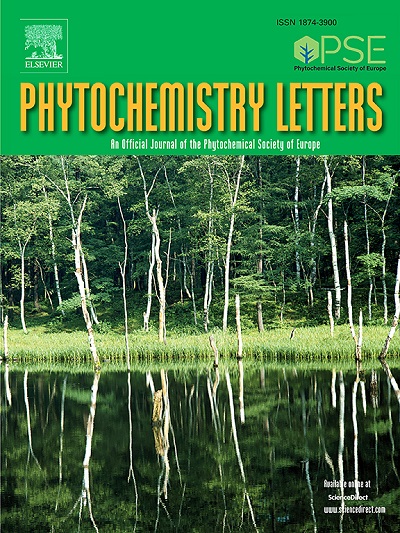Spectroscopic effects on natural occurring O-sulfated flavones from Wissadula periplocifolia
IF 1.3
4区 生物学
Q4 CHEMISTRY, MEDICINAL
引用次数: 0
Abstract
Natural occurring O-sulfated flavonoids have been reported from the plant specie Wissadula periplocifolia Presl. (Malvaceae). Sulfated flavonoids are considered uncommon flavonoid derivatives and the biological relevance of sulfation on specialized metabolites are still poorly understood. In the recent years, the interest on O-sulfated flavonoids has aroused since they have shown anticoagulant, larvicidal and antiproliferative potential. Due the low occurrence of O-sulfated flavonoids the literature is scarce regarding specific isolation, identification and spectroscopic data. In this approach, the complete NMR data of a new bi-O-sulfated flavone isolated from W. periplocifolia are presented. Additionally, based on the obtained experimental and theoretical NMR data, the spectroscopic effects caused by the O-sulfate groups in natural occurring falvones were evaluated in order to better understand the additional effects on multiple O-sulfated compounds. The identified substance was purified from aerial parts of W. periplocifolia using Sephadex chromatographic column. The compound was identified by 1D and 2D NMR and HRMS as the unreported compound 4’-O-methyl-7,8-di-O-sulfate isoscutellarein (telescutellarein). The experimental NMR data was complemented by DFT calculations at the ωB97X-D3/def2-TZVP level of theory. The theoretical NMR spectra were simulated using the GIAO approach, and the observed chemical shifts due to the two O-sulfate groups were analyzed using chemical bond descriptors (QTAIM and OP/TOP) to study the bonds between the aromatic ring and their substituent groups. The anticipated electron-withdrawing and electron-donating effects of the O-sulfate and OH substituents on the aromatic ring were explored through a synergic experimental and theoretical analysis.
求助全文
约1分钟内获得全文
求助全文
来源期刊

Phytochemistry Letters
生物-生化与分子生物学
CiteScore
3.00
自引率
11.80%
发文量
190
审稿时长
34 days
期刊介绍:
Phytochemistry Letters invites rapid communications on all aspects of natural product research including:
• Structural elucidation of natural products
• Analytical evaluation of herbal medicines
• Clinical efficacy, safety and pharmacovigilance of herbal medicines
• Natural product biosynthesis
• Natural product synthesis and chemical modification
• Natural product metabolism
• Chemical ecology
• Biotechnology
• Bioassay-guided isolation
• Pharmacognosy
• Pharmacology of natural products
• Metabolomics
• Ethnobotany and traditional usage
• Genetics of natural products
Manuscripts that detail the isolation of just one new compound are not substantial enough to be sent out of review and are out of scope. Furthermore, where pharmacology has been performed on one new compound to increase the amount of novel data, the pharmacology must be substantial and/or related to the medicinal use of the producing organism.
 求助内容:
求助内容: 应助结果提醒方式:
应助结果提醒方式:


